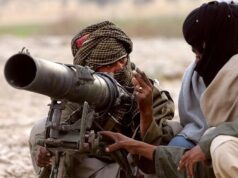Beyond Covid, Australia Will Have To Look Up To “Bhai “ India Rather Than Uncle Sam

Covid – 19 will no doubt have many long-term consequences for the both the Indian Ocean Region and the Indo Pacific, much beyond that we can now only begin to imagine. One consequence that easily comes to our mind is that USA will henceforth be more internally focused. Therefore a country like Australia will have to place greater reliance on regional security partners, such as Japan and India.
India has also slowly woken up to its global and regional responsibilities has started to reorganize its continental land oriented military organizational structures. There have been positive developments, but a lot of problems still lie ahead before India develops full capabilities and future abilities to act as a security provider across the IOR and Indo Pacific.
Last December, after decades of inaction, the Indian Government appointed General Bipin Rawat as India’s first Chief of Defence Staff, theoretically bringing India’s three armed services under unified command for the first time. The CDS will provide a single point Military advise to the Cabinet on military affairs.
The CDS replaces an organisational model for India’s armed forces that was put in place as a temporary measure by the British in 1947. Importantly, this appointment is just the first step in what may become the most significant military reorganisation ever undertaken by India.
From Independence, Nehru and the Congress government kept the military divided, siloed and in practice deeply subordinated to the civilian bureaucrats of the Defence Ministry. There was no institutionalized interaction between the Military and the political functionaries vested with defence of India. As a result, the military remained only at the periphery of governmental decision-making and even defence issues.
Though it is credit to the India’s military that ensured that it stayed well clear of politics. Unlike many post-colonial states, India has not suffered from coups or the hijacking of resources or foreign policy by the military. Though mistakenly many think that this has happened because of “tight “ civil control.
Even today, the idea of a single chief of armed forces has not been welcomed by some vested interest in both the political system and the civil bureaucracy. Fears of militarism and military coups are still being aired by some of the opposition Parties.
Till now the Indian military effectiveness has not been up to the mark. Indian armed forces were quite disjointed at many levels with each of the services doing its own strategy, war planning and capability planning. Operational command was also separated, making joint operations difficult.
Though the creation of HQ Integrated Defence Staff saw raising of tri services Commands like Andaman & Nicobar Command and Strategic Forces Command. Now the Special Forces, Cyber and Space Agency have been added to the list. Also there is a proposal for a tri service Air Defence Command and later may be a Logistics & Transportation Command.
Rawat’s first acts on his appointment as CDS was to propose the reorganisation of the Indian armed forces into unified theatre commands, in addition to tri-service commands for Cyber, Space and Special Forces. This has the long-term potential to transform India’s armed forces into a modern joint military and considerably enhance its effectiveness.
Now coming to the specifics, India too has realized that the next decisive action will be within the Indian Ocean or the Indo pacific rather than on the heights of Dokalam. In this the Indian Navy will be playing major role having a strong power projection ability.
The Navy currently runs India’s only theatre command in the Andaman and Nicobar Islands, seen by some as important to India’s ability to project power into the Pacific. The Indian Navy, which inherited the British Royal Navy’s global perspectives, sees its role as protecting India’s interests wherever they may be, primarily between Hormuz and Singapore, but also potentially much further afield.
Therefore the proposed reorganisation will actually enhance its role. The best way will be to create a Tri Services Southern Penninsula Front. This front should comprise the existing Southern Naval Command, a new South Eastern Naval Command (by hiving off NOIC Bengal and NOIC Orissa from present Eastern Naval Command) and an upgraded ATTK&K Area.
However the real concerns after the Corona virus is defeated will be about India’s defence (and, particularly, naval) spending. Growth in spending may be largely stalled in the face of a weak economy, and we should assume that there will likely be major cuts in defence spending in the wake of the Covid-19 crisis.
That could hit India’s military modernisation plans hard. Its ground force of 1.2 million regular troops which are equally essential against Chinese incursions and Pakistans covert warfare means that the Army will get the most of the defence budget. There may be little left to spend on naval expansion and modernisation.
The Indian Navy has long been the “Cinderella Service” with the smallest budget. In recent years, its share of the defence budget has fallen further, from 18% in 2012–13 to 13% in 2019-20. To put this in context, Australia probably spends considerably more overall than India on maritime security (although Australia’s maritime spending is split between navy and air force).
Budget cuts have already hit the Indian Navy’s plans. Its total planned ships by 2027 have now been reduced from 200 to 175. Future acquisitions of P-8I maritime surveillance aircraft may be reduced. Whether the Navy should go ahead with its planned third aircraft carrier has also come up in debates, suggesting instead that it make greater use of airfields on India’s island territories. The Navy argues that this would not be an acceptable substitute.
These developments contrast with China’s military modernisation program. This included the establishment of five fully integrated theatre commands in 2016, bringing together the army, air force, navy and rocket forces. China’s PLA troop numbers are also steadily being reduced, freeing up money for modernisation and naval spending.
Australia has a big stake in the ability of the Indian military, and particularly its Navy, to deliver effective outcomes right across our shared maritime domain. Therefore it will be in interest of Australia and rest of Oceania that they start taking keen interest in development if the Indian Navy.




